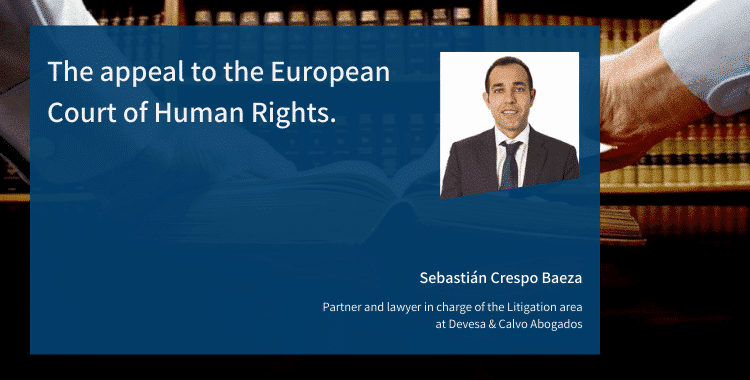
The appeal to the European Court of Human Rights.
The European Court of Human Rights (also known as the Strasbourg Court) is the Court intended to prosecute, the possible violations of rights avowed in the European Convention for the Protection of Human Rights and Fundamental Freedoms, by the member States of the Convention. The guaranteed rights are listed in the stated Convention ant the Protocols 1, 4,6,7,12 and 13, which some States have ratified.
The European Court of Human Rights is a supranational court for human rights protection. Since it is a supranational court it will only be able to have knowledge of the cases in which the national jurisdiction of the member States have not protected or tutored adequately the Human Rights gathered in the Convention. Both a natural and a legal person will be able to be plaintiffs if they consider themselves victims of a Human Rights violation that is included in the Convention. The defendant will be the State signing the Convention.
Alongside the requirements of the substance of the matter and pretrial matters, the Convention establishes certain requirements in which all lawsuits must be fulfilled to be admitted in the procedure and, therefore, to be able to have the substance of the matter fully examined. Thus, formal requirements are crucial because 95% of the present lawsuits before this court are not admitted to procedure.
In essence this are the necessary form requirements for the admission to procedure of the interposed lawsuits:
- The lawsuits must be accurately completed and signed in order to be able to identify the plaintiff.
- The ECHR jurisdiction can only be attended once all the national resources available have been used up to solve the infringement of Human Rights.
- It is necessary that the lawsuit is appealed within the following six months to the exhaustion of internal resources, that is to say, to the resolution of the last national judicial body (in Spain’s case, to the relevant Judgement of the Constitutional Court or a resolution that ends the process followed). This term ends the last day of the six months, even if it is Sunday or holiday.
- It will not be admitted to procedure any lawsuit that is essentially identical as a previous one, in other words, that it is based in the same facts, claims identical infringements and in which active (plaintiffs and victims) and passive subjects (respondent State) are the same. Neither will be accepted any lawsuit that has been submitted previously to another different international instance; the claimed instance should be public, international, independent and judicial.
- It is necessary to complete thoroughly the form provided by the ECHR. Any lawsuit that has an incomplete form will carry the petition’s dismissal or automatic lawsuit. The lawsuit’s form that is thoroughly completed must be appended with every relevant document. Any incomplete lawsuit will be rejected by the Court.
- The occurred facts that unreasonably affected a fundamental right should be clearly presented. The lawsuit cannot be limited to a complaint about a judicial decision that is considered unfair or incorrect. The Court is not an appealing court of state courts and it is not able to cancel or modify its decisions. The lawsuit’s form is provided in the Court’s web.
The Court’s official languages are French and English, but another official language from the States ratified in the Convention can be used to write to the Secretariat.
During the initial phase of the procedure, the Court’s notifications can be perceived in such language. However, in the later phases of the procedure, that is to say, if the Court decides to communicate the case to the defendant State and invite it to present scripted observations of the complaint, every correspondence will be sent in French or English, and one of the two languages should be used in the subsequent allegations.
Lastly, it must be outlined the free lawsuit’s treatment from the ECHR.
Partner and lawyer in charge of the Litigation area at Devesa & Calvo Abogados
